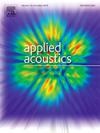Speech intelligibility improvement for public address systems in noisy environments based on automatic gain selection in octave bands
IF 3.4
2区 物理与天体物理
Q1 ACOUSTICS
引用次数: 0
Abstract
A method of speech intelligibility improvement in public address (PA) systems installed in reverberant acoustic spaces is proposed. The method is mainly intended for systems operating in high background noise levels. The algorithm is based on the near end listening enhancement approach. Signal-to-noise ratio (SNR) is evaluated in the octave frequency bands. Signal levels in the acoustic space are estimated using the measured impulse response of the room. Noise level is measured with the microphone, also a method of noise level estimation in presence of speech is proposed. Based on the calculated SNR values, a set of gain limits is selected, which allows for optimal utilization of the available acoustic power. Finally, gain values for the octave bands are calculated and applied to the speech signal. The overall performance of the proposed method was evaluated in a series of experiments performed in real acoustic spaces. Speech intelligibility was estimated using the STIPA index, measured with and without an additional, high-level noise source. The results indicate that the proposed method improved speech intelligibility in all tested cases, compared with the default PA system, especially in presence of a high-level background noise. The proposed method may be integrated with PA systems equipped with a digital signal processor.
求助全文
约1分钟内获得全文
求助全文
来源期刊

Applied Acoustics
物理-声学
CiteScore
7.40
自引率
11.80%
发文量
618
审稿时长
7.5 months
期刊介绍:
Since its launch in 1968, Applied Acoustics has been publishing high quality research papers providing state-of-the-art coverage of research findings for engineers and scientists involved in applications of acoustics in the widest sense.
Applied Acoustics looks not only at recent developments in the understanding of acoustics but also at ways of exploiting that understanding. The Journal aims to encourage the exchange of practical experience through publication and in so doing creates a fund of technological information that can be used for solving related problems. The presentation of information in graphical or tabular form is especially encouraged. If a report of a mathematical development is a necessary part of a paper it is important to ensure that it is there only as an integral part of a practical solution to a problem and is supported by data. Applied Acoustics encourages the exchange of practical experience in the following ways: • Complete Papers • Short Technical Notes • Review Articles; and thereby provides a wealth of technological information that can be used to solve related problems.
Manuscripts that address all fields of applications of acoustics ranging from medicine and NDT to the environment and buildings are welcome.
 求助内容:
求助内容: 应助结果提醒方式:
应助结果提醒方式:


